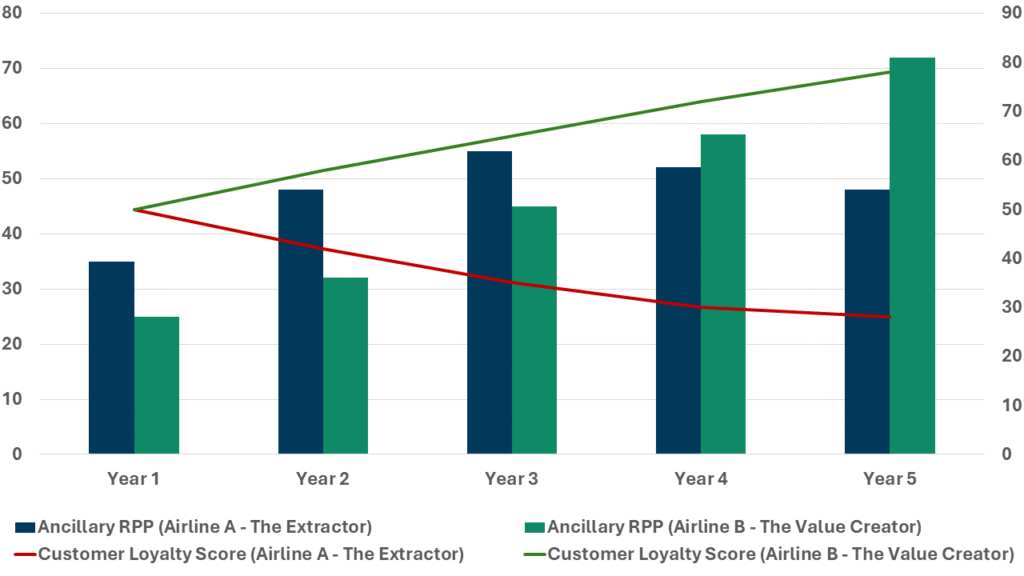Beyond the Seat: The New Frontier of Airline Revenue Management is Ancillary and Personalization
For decades, airline revenue management (RM) was a discipline focused on one primary goal: optimizing seat pricing. Sophisticated algorithms balanced supply and demand to fill planes at the highest possible average fare. This is still the core. But it is no longer the entire game.
The landscape has radically shifted. With rising operational costs and intense competition, profit growth from seat fares alone has plateaued. The new battleground for profitability is not in the cabin, but in everything that surrounds it. Global airline ancillary revenue reached a staggering over $100 billion in 2023. This isn’t just spare change; it’s a fundamental pillar of modern airline finance.
The next generation of airline revenue management is a fusion of advanced data analytics, behavioral economics, and one-to-one marketing. It’s about orchestrating the entire traveler journey to maximize wallet share through personalized ancillary offerings. This article outlines the strategic shift from traditional RM to a holistic, customer-centric revenue optimization engine.
The Ancillary Revolution: From À La Carte to Strategic Value
Ancillary revenue has evolved far beyond bag fees and seat selection. It is now a sophisticated portfolio of value propositions designed to meet diverse traveler needs and unlock new profit pools.
The Strategic Ancillary Portfolio:
-
-
- À La Carte Essentials: This includes checked bags, carry-on bags, pre-selected seats (extra legroom, preferred location), and priority boarding. While now standard, their pricing is increasingly dynamic, tied to demand, route, and booking channel.
- Bundled Value & Branded Fares: This is where strategy truly begins. Instead of nickel-and-diming travelers, leading airlines create tiered fare bundles (e.g., Basic, Standard, Flex, Plus).
- The Psychology: Bundles simplify choice for the customer and increase the perceived value. A traveler paying $50 more for a “Standard” bundle that includes a checked bag, seat selection, and priority boarding feels they are getting a deal compared to purchasing each à la carte ($35 bag + $20 seat + $15 boarding = $70).
- The Reality: The airline secures a higher upfront fare and locks in ancillary revenue early, often with a higher margin than selling items individually later.
- Monetizing the Ecosystem: The most advanced airlines view the entire journey as a revenue stream.
- Loyalty Programs: Often the most profitable “ancillary” of all. Selling miles to credit card partners and banks generates massive, high-margin, counter-cyclical revenue.
- Travel Services: Hotels, car rentals, travel insurance, and airport transfers booked through the airline portal.
- In-Flight & Ground Experiences: Wi-Fi, premium meals, lounge access, and fast-track security.
-
The Power of Personalization: The Right Offer, to the Right Traveler, at the Right Time
Selling a bundle or an ancillary product is one thing. Selling the right one to the right customer is where the true margin lies. This requires a 360-degree view of the customer and predictive analytics.
Building the Personalization Engine:
-
-
- Leverage PNR and Customer Data: Every Passenger Name Record (PNR) is a goldmine of intent. Is it a family of four? A solo business traveler on a tight schedule? A couple on a honeymoon? The composition of the booking dictates the relevant offer.
- Family: Pre-offer seat assignments together, checked bags, and pre-ordered meals for kids.
- Business Traveler: Offer priority boarding, lounge access, and high-speed Wi-Fi to maximize productivity.
- Leisure Traveler: Suggest destination hotels, car rentals, and experience packages.
- Implement Contextual & Dynamic Pricing: The price for an ancillary service shouldn’t be static. It should reflect:
- Demand: Charge more for extra legroom on a fully-booked transcontinental flight than on a half-empty regional route.
- Booking Timeline: Offer a discount on seat selection at the time of booking to secure the revenue early. Closer to departure, increase the price for last-minute travelers who value certainty.
- Customer Value: Offer complimentary perks or discounted upgrades to high-value loyalty members as a reward and to reinforce their status.
- Optimize the Offer Engine: The timing and channel of the offer are critical. The journey has multiple touchpoints:
- At Booking (Website/App): Offer branded fares and core ancillaries.
- Post-Booking (Email/Manage Booking): Target with specific offers like seat upgrades or lounge passes.
- At the Airport (Kiosk/App): Offer last-minute upgrades if the cabin is open.
- In-Flight: Push Wi-Fi access and premium food and beverage options.
- Leverage PNR and Customer Data: Every Passenger Name Record (PNR) is a goldmine of intent. Is it a family of four? A solo business traveler on a tight schedule? A couple on a honeymoon? The composition of the booking dictates the relevant offer.
-
The Data-Driven Revenue Management System
Traditional RM systems optimize for seat revenue. Next-gen systems must optimize for total customer value. This requires integrating siloed data sources.

The Ancillary Revenue Strategy Spectrum: Short-Term Extraction vs. Long-Term Value Creation
A fragmented view leads to missed opportunities. An integrated, AI-powered system allows for holistic optimization of the entire customer journey, from initial search to post-flight engagement.
Case Study: The Power of a Cohesive Strategy
Consider a low-cost carrier (LCC) facing stiff competition on a popular leisure route. Their base fare is $99. A traditional approach might just lower the fare to $89 to compete.
A modern RM approach would be different:
-
-
- Branded Fares: Structure offerings into a $99 “Basic” fare (seat assigned at gate, no bag) and a $139 “Travel Light” fare (includes carry-on, pre-selected seat, and priority boarding).
- Personalization: For a solo traveler booking, the website highlights the “Basic” fare. For a family of four booking, the website proactively recommends the “Travel Light” fare to ensure they sit together and avoid bag fees, emphasizing the total value and avoiding travel-day stress.
- Result: The airline protects its base fare, but the Average Revenue Per User (ARPU) increases significantly. They compete on value and experience, not just on a single price point. They might even win the family’s booking over the competitor offering $89 fares because they solved for the family’s primary anxiety.
-
Conclusion: Integrating the Journey
The future of airline profitability is not just about selling a seat from A to B. It’s about intelligently designing and selling a personalized travel experience. The airlines that will win are those that:
-
-
- View Ancillaries as a Core Strategy: Not an afterthought, but a primary lever for growth and customer satisfaction.
- Break Down Data Silos: Unify PNR, CRM, and loyalty data to build a single customer view.
- Invest in AI-Powered Personalization: Move from segment-based to individual-based offers in real-time.
-
The shift is from managing revenue per available seat mile (RASM) to managing revenue per available customer. This holistic approach transforms the revenue management function from a tactical pricing unit into a strategic center of profitability.
Is your airline leveraging the full potential of ancillary revenue and personalization? Contact us for a strategy session.



